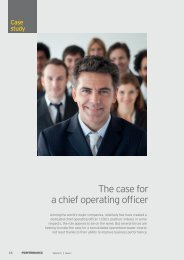PERF RMANCE 04 - The Performance Portal - Ernst & Young
PERF RMANCE 04 - The Performance Portal - Ernst & Young
PERF RMANCE 04 - The Performance Portal - Ernst & Young
Create successful ePaper yourself
Turn your PDF publications into a flip-book with our unique Google optimized e-Paper software.
Coolfarming<br />
<strong>The</strong> second principle is to seed a<br />
community with ideas, to come up with the<br />
new ideas that are outside the box. This<br />
entails thinking the unthinkable, engaging<br />
others in collective brainstorming and<br />
establishing a common vision.<br />
Third, mandate intrinsic motivation and<br />
thus unleash swarm creativity. This ties in<br />
with giving power to the community, letting<br />
it self-organize while providing a nurturing<br />
ground for creative ideas to flower. Trends<br />
can be created with good ideas. Set an<br />
innovative idea free and share knowledge<br />
for free in a community or network. If<br />
the community accepts the new idea and<br />
the community begins to grow, the idea<br />
becomes a new trend. Coolfarmers provide<br />
everything at their disposal to potential<br />
swarms to be creative, and then they let<br />
swarm creativity happen. In a sense, they<br />
“mandate” swarms into action to create<br />
something cool.<br />
<strong>The</strong> fourth principle is to recruit<br />
trendsetters. To create intrinsically<br />
motivated teams, they need<br />
crystallization points in the form of<br />
leaders who embed themselves in their<br />
networks not to be stars but to function<br />
as galaxies. <strong>The</strong>se kinds of leaders have<br />
succeeded in setting trends that literally<br />
changed the world at zero budgets.<br />
COINs ask for a new style of selforganizing,<br />
emergent leadership. Leaders<br />
of self-organizing swarms need to be<br />
“balloon pilots,” not “race car drivers.”<br />
<strong>The</strong>y need to know how to nurture and<br />
create an environment of innovation.<br />
Such leaders must be able to let go,<br />
empowering individual and swarm<br />
creativity by personal example and<br />
trust, not by organizational authority.<br />
This new style of leadership is based<br />
not on best practices, not on cook book<br />
recipes of how to do it one right way,<br />
but on creativity — individual creativity,<br />
and swarm creativity. <strong>The</strong> step I am<br />
proposing is a bold one — empowering<br />
individual people at the company, instead<br />
of collecting power in the hand of the chief<br />
executive who is also the chief executor.<br />
In this new type of organization, there<br />
is no chief executor anymore, this role<br />
has been given away to the stakeholders<br />
of the company. Stakeholders are the<br />
employees, the customers, the suppliers<br />
and the management of the company. <strong>The</strong><br />
managers are not CEOs anymore, but they<br />
are “chief creators,” chief creative officers.<br />
Being highly creative themselves, they<br />
stand out by unleashing the creativity of<br />
their swarm — their employees, their lead<br />
users, their customers and anybody they<br />
touch through their vision and products.<br />
If we look at the leaders who stand out<br />
today, Steve Jobs, Larry Page and Sergey<br />
Brin, founders of Google, Mark Zuckerberg<br />
at Facebook, or Oprah Winfrey, they are<br />
all leaders of multibillion-dollar businesses<br />
which are highly resilient in today’s difficult<br />
economic climate. None of these leaders<br />
has come up the conventional management<br />
way. <strong>The</strong>y were never the CEOs of their<br />
companies in the conventional sense,<br />
never the chief executors. Rather, they<br />
are the chief creators of their respective<br />
enterprises. <strong>The</strong>y might have assumed<br />
the CEO title to make them recognizable<br />
in their role to the rest of the world.<br />
What they really did, however, is not<br />
execute somebody else’s strategy, but<br />
create radically new products, and create<br />
real, sustainable value. <strong>The</strong>y did what<br />
they thought would be the right thing;<br />
7






